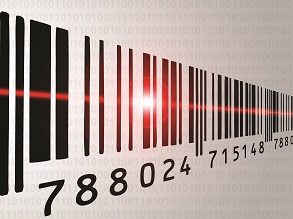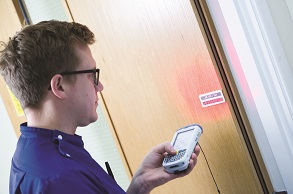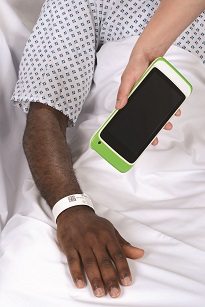Feature / Yes we scan
One year into the NHS e-procurement demonstrator projects, Seamus Ward looks at how the scheme has developed

What’s in a name? Compare ‘the Department of Health e-procurement strategy’ and ‘Scan4Safety’. Though e-procurement is more broadly based, the names have been used to describe the same project – the adoption and use of GS1 barcode standards across the NHS in England. The former sounds a little niche, a bit techy. The latter emphasises that it is a way of improving the safety of patient care and not just a procurement scheme or a way of saving money. That message is vital as the project enters its second year.
Scan4Safety (S4S) has caught the eye of health secretary Jeremy Hunt – well known for his support for technology as a means to deliver improved safety. In late December, he praised the scheme, saying it could save lives and money – potentially £1bn over seven years.
A little over a year ago, six demonstrator sites for the then e-procurement project were announced, with each given around £2m over 24 months. While the NHS remained way behind the commercial sector in its use of technology in procurement, all six were at the forefront of implementing e-procurement in the NHS.
They included Derby Hospitals NHS Foundation Trust and its point of use scanning, which links items used to its stock management and financial systems. This allows the trust to see the procedure performed, the clinicians involved, equipment and prostheses used and time taken in an end-to-end procurement system
The project has six elements, including three core enablers – catalogue management through using GS1 GTIN (global trade item number) barcodes, patient identification using GS1-compliant wristbands and global location numbers (GLNs). These are standards that ensure a trust can identify a person (patient or staff member), place and product.
The successful implementation of these standards will allow value to be generated in the three primary use cases – purchase-to-pay, inventory management and product recall. The PEPPOL standard, which allows organisations to exchange documents electronically, is allied to GS1 barcodes as it supports NHS and supplier computer systems to communicate, underpinning efficient purchase-to-pay systems.
The key enablers and use cases mean that with the patient and product scanned together with their location each time they are moved, treated or product used, not only will a trust know where a patient or a product is, but also can look at their electronic patient records to see which implant or batch of drugs has been received.
In the event of a product recall, this could save days poring over paper records to uncover this information. And, taking it a step further, if clinicians also scan their own ID barcodes, the trust will know who delivered the treatment. In the back office, items should be reordered automatically, while the purchase-to-pay cycle should operate seamlessly, with little human intervention.
GS1 UK head of healthcare Glen Hodgson
(right) says that S4S is about people, products and place. While most of the demonstrator sites will complete their programme between October this year and March 2018, he says the Derby trust is due to have its key enablers and use cases in place by this month.
Overachieving on savings
Although the numbers are not huge – running to a few million pounds – overall the demonstrator sites are overachieving on forecast efficiency savings. ‘The important thing is that this is not a technical project. It’s not about systems, it’s about culture, being transformational and communicating what you are doing, why and how this impacts on patient safety,’ says Mr Hodgson.
He says trusts other than the demonstrator sites continue to show an interest in developing their GS1 compliance. At a national level, the Department of Health and the Treasury are working through a business case that would see S4S rolled out to another 148 acute trusts in four annual waves. This would cost £312m for a return of just over £1bn over seven years – the same return referred to by Jeremy Hunt at the end of 2016. At the moment, the plan is to roll out to 25 trusts in 2017/18 and then around 50 a year from 2018/19.
Healthcare Finance spoke to a number of the demonstrators, each confirming they have made progress and seen benefits. Andy McMinn, chief procurement officer at Plymouth Hospitals NHS Trust, says that during the first 12 months it focused on delivering the core enablers.
The trust has ensured each space has a GLN – helped, he admits, by being in the unusual position of having a software system with every space identified. ‘It goes to show how challenging this is – just the GLNs took us 12 months. For others, it will take another three or four months.’
In addition, admitted patients have a GS1 wristband that uniquely identifies them. However, Mr McMinn acknowledges that there is still some way to go to giving all 85,000 products in its catalogue a GTIN – currently around 16% have a GTIN.
‘That is because it relies on the suppliers adopting GS1 and attributing codes to each of their products. It will take time, but each week we get more and more GTINs,’ he says. The trust is being proactive – it has around 2,300 suppliers and is focusing on the top 80, he adds.
suppliers adopting GS1 and attributing codes to each of their products. It will take time, but each week we get more and more GTINs,’ he says. The trust is being proactive – it has around 2,300 suppliers and is focusing on the top 80, he adds.
Chris Slater, associate director commercial and procurement at Leeds Teaching Hospitals NHS Trust, says it uses around 30,000 different products and, before Scan4Safety, had a number of projects to streamline its supply chain at ward and theatre level. Higher value items had traditionally been ordered by the department that used them, but the trust needed to exert some control so it has also applied inventory management to these items.
Mr Slater says the process of moving the 30,000 items used by the trust to GS1-compliant barcodes is a slow one, but it is progressing as suppliers acquire GTINs for their products and update their packaging.
As with other demonstrator sites, Leeds has focused on areas and items with a high risk or value, such as theatres and hip and knee prostheses, and will continue in this vein. It is currently scanning product barcodes to patients in 29 of its 64 theatres.
‘It’s very much about visibility and transparency. If you link a product to its usage you can ask, “Do we need to hold as much inventory as we have?” You get real time visibility. We have taken about £750,000 of inventory off the shelf since we started the project and this can be reinvested in other things rather than sitting on the shelf.’
Plymouth does not currently scan products at the point of use, though it is developing a system to do this with its partner Genesis that is due to launch in theatres this month. Mr McMinn argues that the problem is that products can contain a number of barcodes with varying information, even when they are from the same supplier. Clinicians cannot reasonably be expected to know which to scan. He says its new system will capture all the barcode information, whatever the standards used, and translate it to information that can be shared across its IT systems.
Though he cannot, as yet, go into detail, he adds: ‘This is about reducing variation and making processes more reliable. Over the next year we will significantly operationalise and broaden point of care scanning. I think that is an exciting development for the NHS.’
Creating value
The trust is going into the second phase. ‘We are moving to the value-creating element of the project – in inventory management, purchase-to-pay and product recall. We are beginning to run GLNs and GTINs through PEPPOL, matching purchase orders to GS1 numbers from machine to machine and aligning them with invoices.’
Initially it will concentrate on a number of areas, such as trauma and orthopaedics, cardiology and pharmacy.
Its finance and accounting provider, NHS Shared Business Services (SBS), is closely involved in the project. Mr McMinn explains: ‘From an SBS perspective, a request placed through a catalogue, generating a purchase order that has GTINs and GLNs and sent through the PEPPOL infrastructure will be processed in the fastest manner. No human hand will be involved. The goods are shipped to us in the shortest lead time and the supplier will be paid quickly.’
The trusts contacted by Healthcare Finance have initially focused on higher value products and meeting the Department of Health expectation that class 3 medical devices (prostheses and other implants) can be tracked to individual patients by the end of the first year.
Mr McMinn says this covers 40% to 50% of a trust’s inventory and 25% to 30% of its expenditure. ‘These are high-spend areas for any hospital and the benefits from a financial perspective are around less waste, better budget setting and more accurate reporting.’
Eventually, he wants to be able to scan all products, though he says it will be several years before all suppliers are GS1 compliant.
David Berridge, deputy chief medical officer at the Leeds trust, believes that although patient safety is one of the key drivers behind the work, operational and financial efficiency follows on from implementing the technology.
GLNs provide a good example, says Mr Berridge, a consultant vascular surgeon. ‘For the first time, we can ensure our clinicians know where their patients are 24 hours a day, seven days a week. For example, there are lots of occasions where a porter goes to a ward to bring a patient for an endoscopy, a CT scan or other test and the patient is not there. For one reason or another, they have been moved to another ward and the information has not been updated. Scan4Safety updates the information in real time, so you won’t get wasted clinical slots.’
Linking patients, patient records and 
procedures and treatments will also reduce never events, he adds. ‘There’s less money sitting on shelves and less risk of products going out of date or, even worse, then being used on patients. It will free up nursing time so they are able to do what they are trained to do. There will be more clinical efficiency, more financial efficiency.’
Mr Berridge accepts it will be a culture change, though the trust will emphasise the benefits of saving clinician time in the long term.
Clinicians will also see the benefit of comparing surgeons performing the same procedure and, adjusting for casemix, reducing unwarranted variations, he adds. ‘If you are more efficient in your list, there’s the potential to add another patient for the same resource. You will also reduce your sterilisation costs and improve patient safety.
‘It brings to clinicians a realisation of the cost of what they are doing. Often you don’t need to do much more than point out the data – surgeons are competitive and they wouldn’t want to be seen as an outlier among their peers.’
The demonstrator sites must pass on their learning – something they are keen to do – but do they have any advice for other trusts? Mr McMinn says: ‘I have one golden rule for other trusts – speak to the demonstrator sites and soak in as much information as you can.’
Leeds’ Mr Slater adds: ‘It’s a change management project and this needs to be understood, not just in financial terms, but also in clinical terms and in terms of the benefits to the patient. We are one of the biggest trusts in the country, so if Leeds can do it, anyone can.’
E-procurement has a patchy history in the NHS, with many false starts in recent years. The service will be keen to hear the decision on the roll-out business case, but with a mandate to implement GS1, the strong support of the health secretary and its potential to deliver safer care more efficiently, it looks like Scan4Safety will go NHS-wide.
Salisbury stays ahead
Salisbury NHS Foundation Trust is well known for being advanced in many aspects of e-procurement, but the Scan4Safety demonstrator programme has helped it move further, faster, according to Rob Drag, its GS1 and PEPPOL programme manager.
He says that around 12 months ago the trust used some inventory management and was well advanced in catalogue management, but was less so in terms of patient wristband identification. S4S brought together workstreams across the trust and has also given the patient ID programme a shot in the arm.
‘We identified the areas where it would be beneficial and then the challenge was to change the systems,’ he says. ‘Previously, a nurse would have to log onto the system and choose the right patient, but now they just have to scan the wristband and the system immediately goes to the patient.’
The scheme has been piloted on a surgical ward, with a full roll-out planned. Though hard cash savings are hard to quantify, there have been benefits. For example, it can help stop patients being given the wrong blood product, with the potential to alert the clinician on a mismatch at a number of points in the process.
The trust has also made progress towards ensuring all parts of the hospital have a location code. Mr Drag says the first step was to ensure computerised or CAD drawings were up to date; the next is to assign barcodes to locations and use them.
The trust is working with suppliers to ensure compliance with GS1 barcodes and rolling out an inventory management system with hand-held scanners. In cardiology, one of the first areas of the trust to use the technology, a scan will show a product expiry date, giving extra protection for the patient before it is used. The information also automatically feeds into the service line reporting and costing systems, generating valuable management information.
The system will be rolled out next to orthopaedics and will eventually cover all departments, ‘from catering to cardiology’. The complexity of inventory management depends on the needs of each specialty or service. At one end of the spectrum, surgical specialties might require detailed track and trace capability; at the other, non-clinical areas will need less sophisticated tracking.
Inventory management means clinicians spend less time ordering stock, he says. It has led to stock reduction, saving £148,000 in pharmacy, £65,000 in theatres and £30,000 in cardiology. In orthopaedics, the trust has identified £50,000 worth of out-of-date stock, which, as a one-off, the supplier has agreed to swap for in-date products.
Related content
The Institute’s annual costing conference provides the NHS with the latest developments and guidance in NHS costing.
The value masterclass shares examples of organisations and systems that have pursued a value-driven approach and the results they have achieved.